This November the MACMA team puts on their backpacks and lets themselves be guided by Xavi Escriva Dura, a cycle tourist and nature lover, traveling self-sufficiently, adapting to the road and living simply, learning from each culture and landscape. In this experience we will visit different villages and pass by many springs, a historical, landscape and heritage experience through the interior of the Marina Alta.

A LITTLE HISTORY. We know where we come from to decide where we are going.
In the late 1800s, walking within a city was expensive and costly. Traveling far was slow and tedious, while a horse or train were expensive and required coordination with others. Neither of these modes were available to everyone, least of all to women.
At the end of the 19th century bicycles entered the scene and were an admirable technical achievement, but as a sociocultural force, they were even more revolutionary for the mobility of the time.
Allowing an individual to look ahead and pedal toward it created and began to democratize the horizon. I think that's precisely what is meant when it is said that cycling is freedom.
Yes, it is freedom, literal; in the sense that the bicycle goes where one wants to go, and it is also a deeper freedom in the fact of creating those dimensions that did not previously exist in the usual time and space.
Jules Verne's Around the World in Eighty Days was undoubtedly a fascinating story of its time, but it was fiction. In 1886, "Thomas Stevens," an Englishman living in the United States, set out from San Francisco to cycle around the world on a high-wheel bicycle. He completed a monumental journey, as he describes in the book "Around the World in a Bicycle," but it was the rise of bicycles with two wheels of the same size and chain that accelerated and made bicycle travel more common.
"Annie Cohen Kopchovsky", for example, was the first woman to circumnavigate the world by bicycle, in 1894, becoming a sports star.
Many things have changed since then, and bike trips have evolved into an endless variety of modalities and styles. I won't try to narrow down bike trips, I prefer to leave them open for everyone to make their own; the bike, the distance, the pace, the saddlebags, in short; the trip.
Advantages of traveling by bike:
- Total autonomy, everything we need to live in a few saddlebags.
- It does not consume fuel, the fuel cost is zero.
- It is respectful of the surroundings and the environment, does not pollute or make noise, does not bother neighbors and does not create traffic jams,
- It connects us with the environment and the people of the places we visit, as we travel at a slow pace.
Precautions and recommendations to follow:
- Although the route is laid out along county roads, secondary roads and paved paths, it is up to each of us to decide the final route we will follow, analyzing the route we like best at each moment.
- The bicycle is a vehicle and consequently must comply with traffic regulations and respect other users, especially pedestrians.
- We can drive on any road that does not indicate otherwise, and vehicles must respect the safety distance when overtaking.
- It is advisable to wear reflective material if you are riding on roads with a lot of traffic or poor visibility, and to carry lights with charged batteries in case you need them.
PROPOSED DAYS. Step by step we are making our way.
We propose a cycle tour through the valleys of the Marina Alta, that is, by bike and with panniers. On our bike we will carry everything we need.
The experience is designed to be carried out over four consecutive days in an itinerant manner. However, it is perfectly adaptable to be carried out over two weekends or in stages.
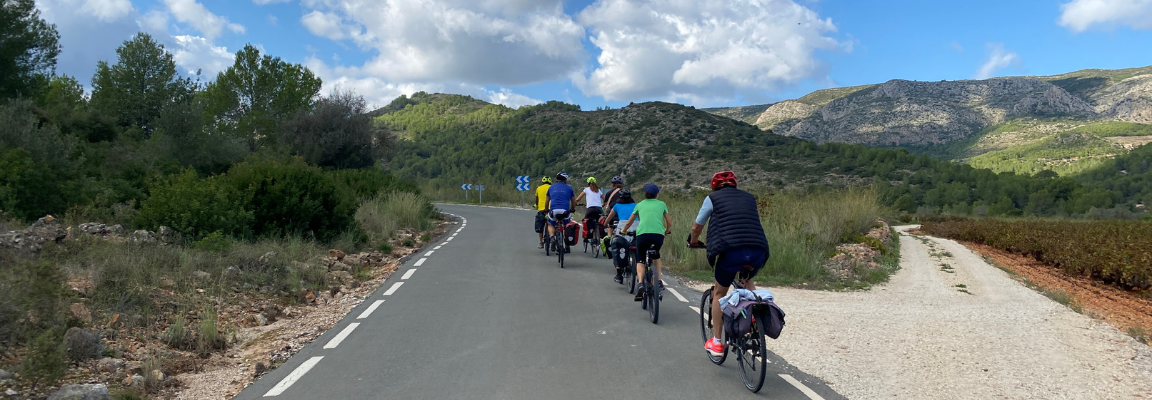
We will take advantage of the month of November where the withered leaves change colors and dress the mountains in autumn, giving us, if possible, unforgettable postcards of our valleys. A time of bloodshed for those who know where to find them, to prepare the beds for winter sowing and for astronomy lovers, this month of November you will be able to contemplate the comet “Lemmon”, or “Halloween”, which completes one orbit every one thousand one hundred and fifty years, a unique opportunity to see it.
As for the necessary equipment, we took a tent to spend the night, but you will find many accommodations in the towns along the route. We made our meals by buying local products in the markets we found and in bars and restaurants.
The difficulty of each stage will be indicated in points from 1 to 5, with 1 being the easiest and 5 the most technical, scoring each aspect of difficulty; Positive gradient, density of motorized traffic and pavement.
Well, without further ado, let's get straight into the route.
Day 1: Orba - La Vall de Laguar
Difficulty
- Positive slope: 3
- Traffic: 4
- Pavement: 2
We meet at 9:30 in Orba , where we start today's day.
We cross the town of Orba, passing first by the Museu del Fang, then by the town square, going around the church of El Naixement del Senyor , presumably also built on top of a mosque. We continue along the avenue of Dénia and head towards Benidoleig. Our first stop is at the Cova de Les Calaveres, which owes its name to the discovery of twelve human skulls, which gave rise to several stories and legends.
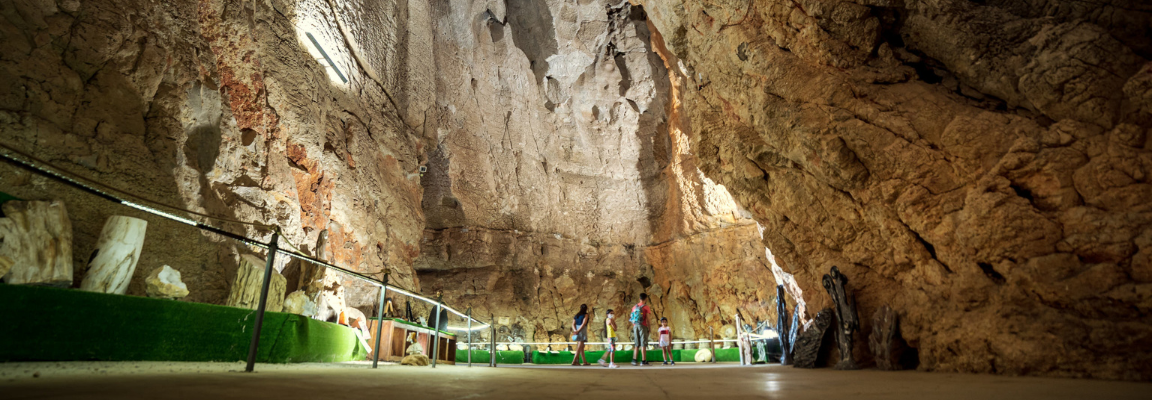 Cova de Les Calaveres - Benidoleig
Cova de Les Calaveres - BenidoleigAccording to Cabanilles, they would be the skeletons of twelve Muslim farmers, although this is just one theory among others. Right on the slope of the gate we find the house in the shape of a guitar that was the residence of the painter "Eladi Calleja", originally from Xàbia and a friend of Pedreguer. Calleja was without a doubt a very particular character, bohemian, vagabond and guitarist, he embarked on a cod ship that took him to Reykjavík, from where he moved to Greenland where he lived with Eskimos, eventually residing in Norway, where he owned a hotel for artists, where overnight stays were often free.
His love affairs led to a relationship with Nico, the German artist, singer of "Velvet Underground", member of "Andy Warhol's Factory", who also resided in this house.
We continue our way along the CV-733 road to the Campell en Pedreguer road , where we leave the road to visit the Clot del Lirio and the Benimarmut tower. About five hundred meters inland we find the Clot del Lirio. It is an 80-meter-deep chasm that suddenly opened, passing over an entire terrace of orange trees on the morning of August 8, 1982. The elders say that the tremor was even felt in the village.
We resume our journey through Pedreguer and head towards Gata de Gorgos . At this point you can choose to take the CV-732 road or go along paths parallel to the road, I leave it to your choice, we have chosen the road. When we arrive at the La Caleta warehouse, we take the Camí dels Plans, where we will have to dismount from the bike to overcome a concrete wall that we will pass by a path right next to the wall and very carefully we head along the edge of the road towards the path again. Then we continue along the N-332 road to Gata de Gorgos.
Here in Gata there are numerous shops on the same road, with numerous items made of tin, wicker, bamboo and esparto.
We take the opportunity to have breakfast and continue our journey towards Llíber.
The Llíber road runs between vines and dry stone banks through the Gorgos valley, it is narrow, but the vehicles are respectful of cyclists and you can circulate calmly. We turn off onto the Camí de la Bassa to enter Llíber, we walk around the town a little and take the opportunity to make a short stop. We continue through the streets of the town until the exit, where we stop to see the Riurau de Paco Guarero, which can be perfectly seen from outside the fence. We then continue towards Xaló surrounded by the very particular setting of the Pla de Llíber.
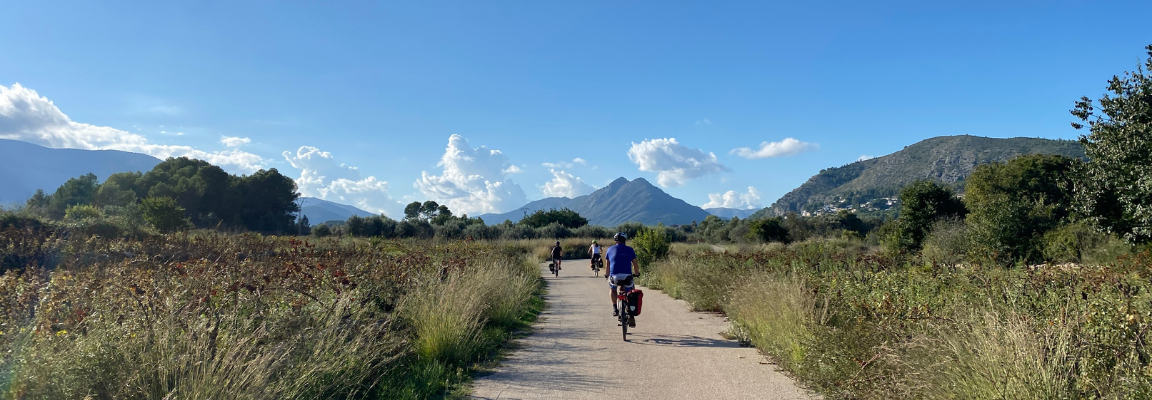 Road from Xaló to Parcent
Road from Xaló to ParcentUpon arriving in Xaló we took the opportunity to buy some local products, stocking up for a small picnic in the area of the Sant Joan de Mosquera hermitage, an old farmhouse that once had forty houses and was depopulated in 1609 with the expulsion of the Moors. It is said that the porrat was celebrated here before being moved to Alcalalí.
It also preserves a 13th century sénia very close to the hermitage itself, although unfortunately it cannot be visited at present, as it is fenced off, but it can be seen from the outside. The hermitage has a porch where it is cool on sunny days and where we can also protect ourselves from some rain.
After lunch we continue our way to Parcent along the camí de pedra i aigua of the Vall de Pop. In Parcent we stop for a coffee at the Cooperativa bar, a 19th century building that was used as a mill, currently it is a social center and space for cultural events in the town. We start the march again towards the washhouse crossing the town, the Llavador de Parcent is an building that was restored in 1990 and is preserved in very good condition.
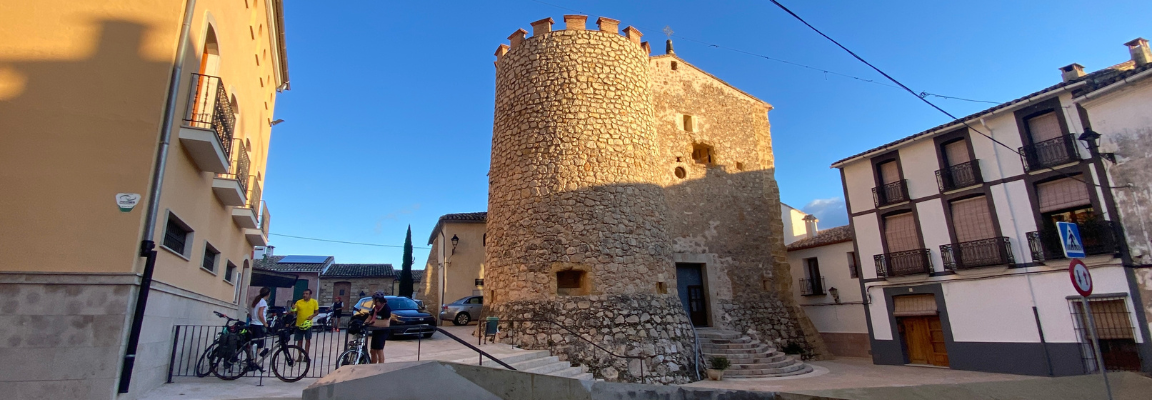 Fortified Church of Sant Miquel Arcàngel - Murla
Fortified Church of Sant Miquel Arcàngel - MurlaThe next destination is Murla, where we visit the fortified church of Sant Miquel Arcàngel , formerly Pop Castle. Strategically located between the valleys of Alcoià and Marina Alta, it was the center of operations for the treaties for the expulsion of the Moriscos from the valleys.
It owes its defensive appearance largely to the fires and attacks by the pirate Barbarossa's corsairs, who forced the Dukes of Gandia to cede it to enable it to be used as a fortified church, modifying its original appearance.
We rest for a while, fill our water bottles and head towards Fontilles along the Vall de Laguar road . A few kilometres later we turn right onto a road that runs alongside the walls of the Fontilles sanatorium. The toponym Fontilles seems to derive from the abundant springs in the Valley, which belong to the Penyal aquifer, among which the Castellet spring stands out , providing the sanatorium with the necessary water. The sanatorium of Fontilles is closely linked to Leprosy, it was set up during the 20th century to cover the growing demand for this disease.
We then head towards the first town in the Vall de Laguar, Campell, where we will spend the night at the Vall de Laguar camping site . After arriving at the campsite and setting up our tents, we still have a little bit of light, so we take advantage of it to visit the ice spring and el llavador that is a little further down from the camping site.
Day 2: La Vall de Laguar - Castells de Castells
Difficulty:
- Positive slope: 4
- Traffic: 2
- Pavement: 2
This stage is characterized by positive elevation gain, since even though it is only a few kilometers long, the coastline is very steep and persistent, particularly during the first part of the day.
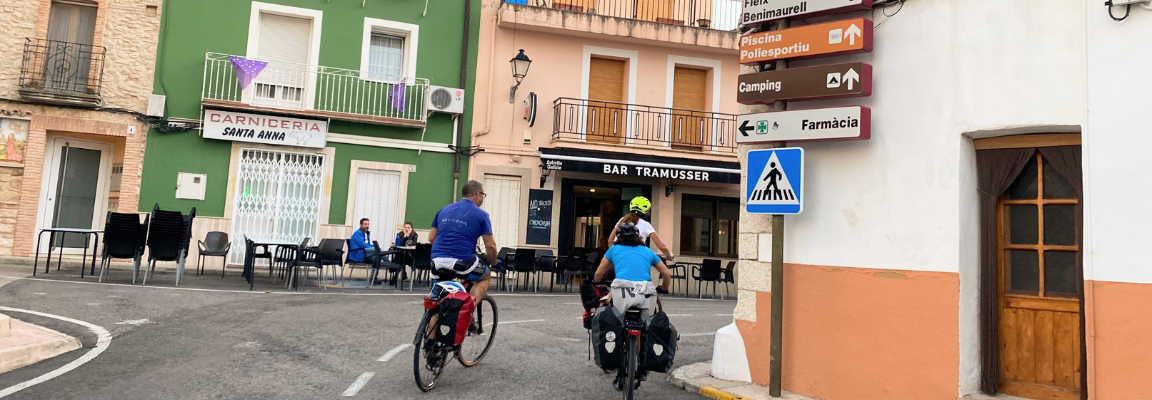 Entrance to Campell - La Vall de Laguar
Entrance to Campell - La Vall de LaguarThe day dawns with fog and slightly cloudy skies, but none of this prevents us from enjoying a magnificent dawn, the panoramic views offered by the Vall de Laguar campsite are magnificent. We set up the tent and have breakfast in a small bar in the village and without further ado we set off towards the Font del Gel where we load water and head towards the next village, Fleix.
Upon arriving in Fleix we turn off onto the Cantorres road where we will make our first stop at the llavador of Fleix, which stands out for its decoration with tiles with stone walls and openings on two sides and oculi at the top that give it a very characteristic appearance.
We continue uphill and overcome the first steep slopes, we place the appropriate bike gears and very calmly and without rushing we overcome them one after the other.
A little further on we are surprised by a huge rock that marks the curve of the road and which is shaded by a holm oak tree, creating a very picturesque landscape. The next stop is at the Font de Benimaurell. We then head towards the town, first overcoming the last coastal road, here we have to get off the bike, as it is very steep. We rest for a while in Benimaurell and take the opportunity to eat something before tackling the coastal roads that remain before reaching the Garga pass. After Benimaurell the climbs are very steep, but we overcome them very calmly and without any hurry until we reach the Garga pass, which offers us magnificent panoramas with the Montgó in the background and Eivissa and Formentera to its right.
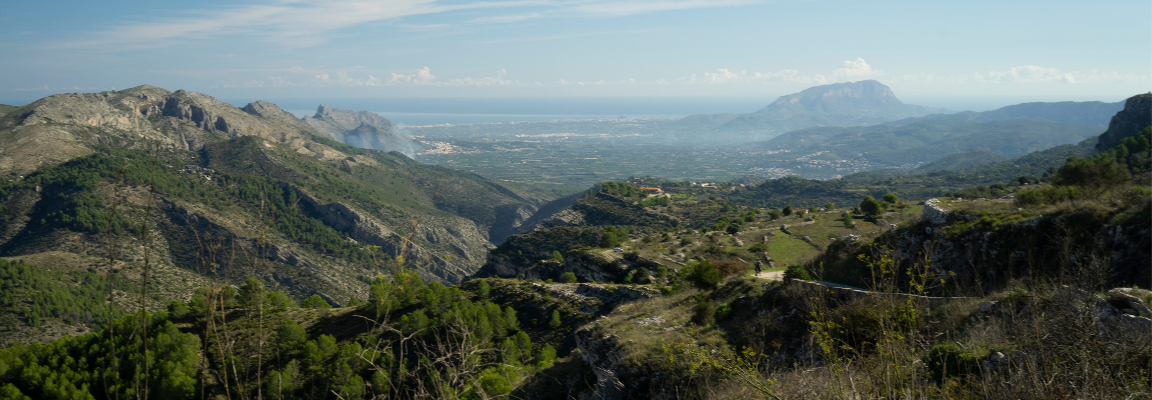 View of the Collado road
View of the Collado roadThe Coll de Garga was a passageway between the plain of Petracos and the Vall de Laguar, between the Cavall Verd and the Serra de la Carrasca.
We then take the small path towards the Petracos plain, this descent makes us forget the effort of the climbs enjoying the panoramic views of Serrella, Aitana and Aixortà. When we reach the road we turn right to visit the rock paintings of the Petracos Plain. The site of the Petracos Plain was discovered in 1980, and is considered one of the most important of the Macroschematic Art of the Valencian Country, characterized by the remarkable size of the figures represented, it was declared a World Heritage Site by UNESCO. If you don't have binoculars, don't worry, you can walk to the fence where they can be seen perfectly.
After visiting the Petracos site and its cave we return to the CV-720 road, and we do not leave it until we reach Castells de Castells, where we head to the Castellet area to spend the night. We overcome the last slopes calmly and arrive at the Camping area, the place is wonderful, right on the slopes of Aixortà and with unbeatable panoramic views.
Day 3: Castells de Castells - Alcalá de la Jovada.
Difficulty:
- Positive slope: 3
- Traffic: 3
- Pavement: 4
We start the day having breakfast and gaining strength for today's day. In Castells we find a few bars that open early in the morning, a bakery, and on Saturday morning there is a market in the town square.
Once ready, we leave the recreational area of the castle to climb the path that takes us to the road. It is a concrete road with a corrugated surface and a steep slope, but it is quiet and we shorten a good stretch to the road. When we reach the road we face the ascent towards the Vall de Seta. The next town is Famorca. The ascent is continuous but not too steep. In Famorca there are restaurants and a fountain right next to the village washhouse, the font del llavador. We take the opportunity to load the water drums and take a walk around the town. Then we continue the ascent towards Fageca. In this case we have chosen to take the path from Famorca to Fageca, the path is concrete and with very steep slopes, further on it is just a stone path, but it is quiet and very beautiful, you can choose the road if you want to go faster. In Fageca we find some restaurants and bars, we make a stop and head towards Tollos with the unparalleled views of the background of La Serrella and the Seta valley, with the geological beauty formed by the Quatretonda needles and the Serrella quarries. When leaving Fageca we find a lime kiln right next to the road, it is located approximately one kilometer from Fageca next to the path that goes to the Font del Molí recreational area. At the next intersection, we turn towards Tollos leaving Benimassot on the left. In Tollos we also have some bars and restaurants that are open on weekends and holidays.
We continue our journey and head towards Beniaia , but first we will have to overcome the Tollos pass, 830 metres above sea level. In Beniaia we will find a small fountain to the left of the village, on the road that takes us towards the Despoblat morisc de la Queirola. We head towards of Beniaia. At this point you can decide again whether to take the Benialís path or the road, the road is quite mountainous and makes some turns. We also take it to visit the Benialís settlement. Once here, we are surprised just to imagine what life was like in the past in these villages, it is fascinating to simply contemplate the living memory of each stone of these buildings. Seven families lived in the Benialís settlement in 1600 and it was left depopulated after their expulsion.
Then we continue our journey along the road to Alcalá de la Jovada, where we will spend the night today, but not without first stopping to contemplate the Alcalá aqueduct bridge and the emblematic Al-Azraq fountain.
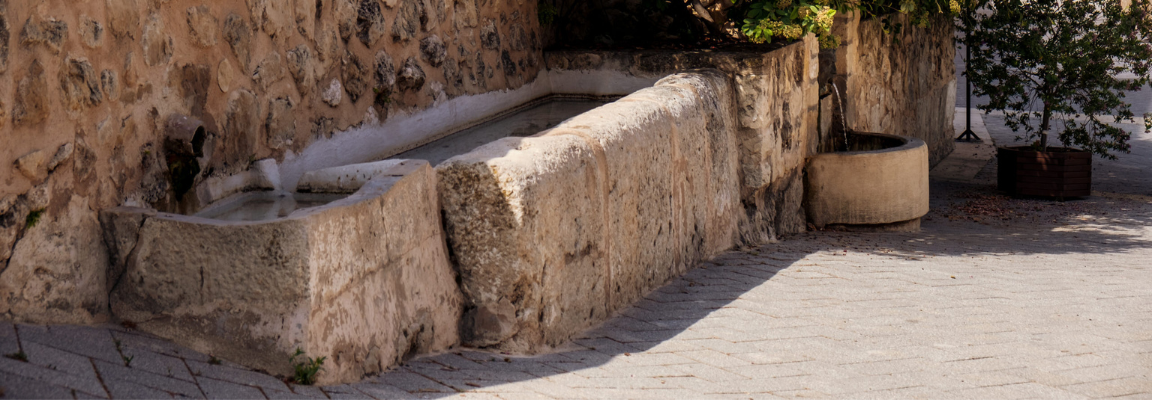 Al-Azraq Fountain
Al-Azraq Fountain To speak of Alcalà de la Jovada is to speak of Al-Azraq, a leader born in Alcalà between 1218 and 1220, who dared to stand up to the army of Jaume I and revolted three times. According to the documentation, he had “són alberch mayor” in Al-qa'la (the castle), located in the current term of the la Vall de Gallinera, and which at that time formed part of the Vall de Alcalà together with Benissili the last town of the current Vall de Gallinera.
Day 4: Alcalá de la Jovada - Pego
Difficulty
- Positive slope: 2
- Traffic: 3
- Pavement: 3
We get up early to face the last day of the route to Pego , where we will finish the walk. The day is sunny and a little cold, but without too much wind, and even so, up here a windy day is not to be taken lightly, here when the wind blows it really blows. We pedal for a while to warm up until the first town we come across, Margarida, which surprises us on the left just after a bend. We stop to visit the town and continue the walk towards the Vall de Gallinera. We have to be careful now, since a few meters ahead, at the next intersection, we will turn right. We overcome a few curves without much ascent until we immediately see some towers of the remains of the castle of Benissili or Gallinera, drawing a carved mountain almost perfect to house a defensive Watchtower of this magnitude, reminding us of some of the "Kasbah or Ksar" that still remain in Morocco. After passing the Benissili pass 571 m, we leave the road to head towards the town of Benissili. In Benissili we make a stop at the Font del Llavador , we stock up on water and continue.
We stop again at Llombai, the next village of the eight that make up the Vall de Gallinera. The village is made up of thirteen houses, fortunately inhabited today, but it has not always been like this, since not too many years ago the village was abandoned. The most beautiful corner of the village is the fountain and the old washhouse, where there was even natural grass. Some stories of the village are also told, such as the passage of a character from a rather murky past "Stefan-Gregor Raiter", known as the Nazi of Llombai, who found peace and tranquility in this abandoned village. It is said that he was the head of a crematorium for Hitler, and arrived in La Gallinera around the forties to take refuge from justice.
A few years later, his Mercedes was found in a walled-up garage, which he had hidden well so as not to arouse suspicion. It is also said that a mountain refuge was built very close to Benissili Castle to go unnoticed if things got complicated.
We continue our journey towards Alpatró, the next town in the Vall de Gallinera.
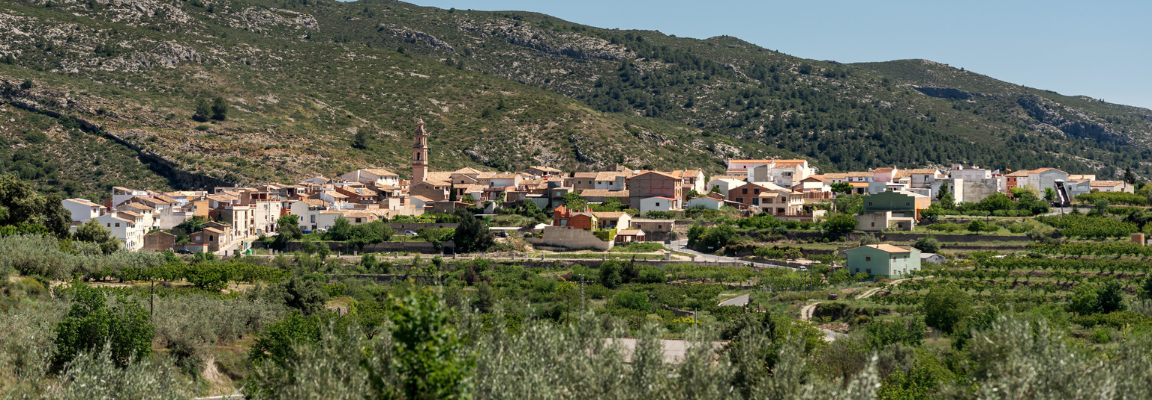 Alpatrón - La Vall de Gallinera
Alpatrón - La Vall de GallineraWe continue the descent through the Gallinera valley enjoying the landscapes and surrounded by cherry trees until we reach Benissivà, where we enter the village going down towards Benialí along the Camí Reial. This path is easy and is in good condition. When we reach the road we take the Benirrama path along the Camí de l'Alcúdia. This route can be avoided by continuing along the road, but the path is very beautiful and quiet, at the same time as it crosses the village and the Benimarsoc fountain and the Font de la Mata. We pass Benirrama and head back to the road along the Camí de la Font de la Mata. A little further on we turn off towards Forna to visit the last castle in the Valley.
Forna was born as a small farmhouse that would depend, in Andalusian times, on the castle of Benirrama or Ambra and would also house a secondary surveillance point, a watchtower.
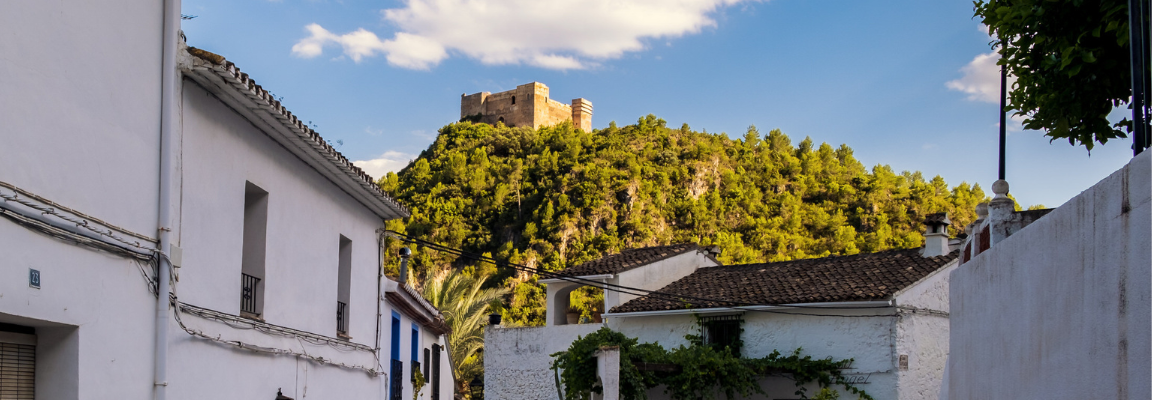 Forna Castle
Forna CastleIt will be this watchtower with its cistern, which would later become, with the arrival of the Cruïlla family, a stately palace in the Valencian civil Gothic style, very characteristic of the last third of the 15th century. This castle-palace has a quadrangular plan with a central courtyard at 2 heights and topped by 4 towers, one at each end. Built in stone, tile and stucco.
The graffiti that is found along the interior and exterior route stands out. We find graffiti that is both decorative and more related to leisure, day to day life or hobbies. After visiting the Forna castle we continue our journey towards Pego, not without first making a stop at the recreational area of Tossal del Llop, with its Canelobre cave . Immediately after, as night falls, we head towards Pego and after hugging each other sadly we say goodbye until the next one.
And that's it for this month's experience, the valleys of our region offer us an endless number of wonderful places full of beauty, history and heritage, now it's our turn to discover them, enjoy them and respect them.
The Marina valleys are mountainous, we will have to make an effort to overcome some steep slopes, but, calmly, without rushing, and enjoying the surroundings, we will have overcome them almost without realizing it.
I wish you a day full of enchanting landscapes, good vibes and unforgettable moments, I hope you enjoy it a lot.
This experience is designed to be done in four days in an itinerant way, however, it can be done with two weekends or even, adapt the stages to the time you have and your level of physical fitness. We propose some routes, spaces and buildings to visit, but each person can adapt the experience to their abilities, physical resistance and interests. If you want to expand information or elements to visit in each town, you can enter the website of Descobrim la Marina Alta and adapt the experience to your tastes with the backpack.

AND MORE. On the table and in bed at the first cry.
 Where to buy |  where to eat |
 where to sleep |  Activities and others |